Effects of Process Variables on Physico-Mechanical Properties of Abura (Mitrogyna ciliata) Sawdust Briquettes
Abstract
1. Introduction
2. Materials and Methods
2.1. Acquisition and Properties of Sawdust
2.2. Experimental Briquetting Press
2.3. Design of Experiment
2.4. Determination of Mechanical Properties of Briquettes
2.4.1. Compressive Strength
2.4.2. Shatter Index
2.4.3. Density
2.5. Statistical Analysis
3. Results and Discussion
3.1. Compressive Strength Analysis
3.2. Shatter Index Analysis of Briquettes
3.3. Density Analysis of Briquettes
3.4. Relationship between Quality Parameters
4. Conclusions
Author Contributions
Funding
Institutional Review Board Statement
Informed Consent Statement
Data Availability Statement
Acknowledgments
Conflicts of Interest
References
- Aremu, J.O. Epileptic Electric Power Generation and Supply in Nigeria: Causes, Impact and Solution. J. Contemp. Res. Soc. Sci. 2019, 1, 73–81. [Google Scholar] [CrossRef]
- Jekayinfa, S.O.; Orisaleye, J.I.; Pecenka, R. An assessment of potential resources for biomass energy in Nigeria. Resources 2020, 9, 92. [Google Scholar] [CrossRef]
- Obi, O.F.; Okongwu, K.C. Characterization of fuel briquettes made from a blend of rice husk and palm oil mill sludge. Biomass Convers. Biorefin. 2016, 6, 449–456. [Google Scholar] [CrossRef]
- Roy, R.; Ray, S. Effect of various pretreatments on energy recovery from waste biomass. Energy Sources Part A Recovery Util. Environ. Eff. 2023, 45, 9616–9628. [Google Scholar] [CrossRef]
- Jekayinfa, S.O.; Scholz, V. Potential availability of energetically usable crop residues in Nigeria. Energy Sources Part A Recovery Util. Environ. Eff. 2009, 31, 687–697. [Google Scholar] [CrossRef]
- Ndukwu, M.C.; Onwude, D.I.; Bennamoun, L.; Abam, F.I.; Simo-Tagne, M.; Horsfall, I.T.; Briggs, T.A. Nigeria’s energy deficit: The challenges and eco-friendly approach in reducing the energy gap. Int. J. Sustain. Eng. 2021, 14, 442–459. [Google Scholar] [CrossRef]
- Ojolo, S.J.; Orisaleye, J.I.; Ismail, S.O.; Abolarin, S.M. Technical potential of biomass energy in Nigeria. Ife J. Technol. 2012, 21, 60–65. [Google Scholar]
- Zubairu, A.; Gana, S.A. Production and characterization of briquette charcoal by carbonization of agro-waste. Energy Power 2014, 4, 41–47. [Google Scholar]
- Jekayinfa, S.O.; Adebayo, A.O.; Oniya, O.O.; Olatunji, K.O. Comparative analysis of biogas and methane yields from different sizes of groundnut shell in a batch reactor at mesophilic temperature. J. Energy Res. Rev. 2020, 5, 34–44. [Google Scholar] [CrossRef]
- Jekayinfa, S.O.; Olorunmaiye, J.A.; Ogunsola, A.D.; Soji-Adekunle, A.R. Evaluation of petrol and ethanol mixture as a fuel for gasoline engines. Adeleke Univ. J. Eng. Technol. 2018, 1, 139–148. [Google Scholar]
- Ojolo, S.J.; Orisaleye, J.I. Design of a laboratory scale biomass gasifier. In Building a Non-Oil Export Based Economy for Nigeria: The Potential of Value-Added Products from Agricultural Residues; Jekayinfa, S.O., Ed.; Cuvillier Verlag: Göttingen, Germany, 2012; pp. 61–68. [Google Scholar]
- Ojolo, S.J.; Orisaleye, J.I. Design and development of a laboratory scale biomass gasifier. J. Energy Power Eng. 2010, 4, 33. [Google Scholar]
- Ogunsina, B.S.; Ojolo, S.J.; Ohunakin, O.S.; Oyedeji, O.A.; Matanmni, K.A.; Bamgboye, I.A. Potentials for generating alternative fuels from empty palm bunches by pyrolysis. JOMAR 2014, 8, 50–60. [Google Scholar]
- Orisaleye, J.I.; Jekayinfa, S.O.; Pecenka, R.; Ogundare, A.A.; Akinseloyin, M.O.; Fadipe, O.L. Investigation of the effects of torrefaction temperature and residence time on the fuel quality of corncobs in a fixed-bed reactor. Energies 2022, 15, 5284. [Google Scholar] [CrossRef]
- Pecenka, R.; Lenz, H.; Jekayinfa, S.O.; Hoffmann, T. Influence of tree species, harvesting method and storage on energy demand and wood chip quality when chipping poplar, willow and black locust. Agriculture 2020, 10, 116. [Google Scholar] [CrossRef]
- Orisaleye, J.I.; Jekayinfa, S.O.; Ogundare, A.A.; Adefuye, O.A.; Bamido, E. Effect of screen size on particle size distribution and performance of a small-scale design for a combined chopping and milling machine. Clean. Eng. Technol. 2022, 7, 100426. [Google Scholar] [CrossRef]
- Orisaleye, J.I.; Ojolo, S.J.; Ajiboye, J.S. Mathematical modelling of die pressure of a screw briquetting machine. J. King Saud Univ.-Eng. Sci. 2020, 32, 555–560. [Google Scholar] [CrossRef]
- Aina, O.M.; Adetogun, A.C.; Iyiola, K.A. Heat energy from value-added sawdust briquettes of Albizia zygia. Ethiop. J. Environ. Stud. Manag. 2009, 2, 42–49. [Google Scholar] [CrossRef]
- Liu, Y.; Wang, X.; Xiong, Y.; Tan, H.; Niu, Y. Study of briquetted biomass co-firing mode in power plants. Appl. Therm. Eng. 2014, 63, 266–271. [Google Scholar] [CrossRef]
- Tembe, E.; Otache, P.; Ekhuemelo, D. Density, shatter index, and combustion properties of briquettes produced from groundnut shells, rice husks and saw dust of Daniellia oliveri. J. Appl. Biosci. 2014, 82, 7372–7378. [Google Scholar] [CrossRef]
- Obi, O.F.; Olugbade, T.O.; Orisaleye, J.I.; Pecenka, R. Solid Biofuel Production from Biomass: Technologies, Challenges, and Opportunities for Its Commercial Production in Nigeria. Energies 2023, 16, 7966. [Google Scholar] [CrossRef]
- Jha, P.; Yadav, P. Briquetting of saw dust. Appl. Mech. Mater. 2012, 110–116, 1758–1761. [Google Scholar] [CrossRef]
- Setter, C.; Silva, F.T.M.; Assis, M.R.; Ataíde, C.H.; Trugilho, P.F.; Oliveira, T.J.P. Slow pyrolysis of coffee husk briquettes: Characterization of the solid and liquid fractions. Fuel 2020, 261, 116420. [Google Scholar] [CrossRef]
- Obi, O.F. Effect of briquetting temperature on the properties of biomass briquettes. Afr. J. Sci. Technol. Innov. Dev. 2015, 7, 386–394. [Google Scholar] [CrossRef]
- Lela, B.; Barasic, M.; Nizetic, S. Cardboard/sawdust briquettes as biomass fuel: Physical-mechanical and thermal characteristics. Waste Manag. 2016, 47, 236–245. [Google Scholar] [CrossRef] [PubMed]
- Orisaleye, J.I.; Jekayinfa, S.O.; Adebayo, A.O.; Ahmed, N.A.; Pecenka, R. Effect of densification variables on density of corn cob briquettes produced using a uniaxial compaction biomass briquetting press. Energy Sources Part A Recovery Util. Environ. Eff. 2018, 40, 3019–3028. [Google Scholar] [CrossRef]
- Orisaleye, J.I.; Jekayinfa, S.O.; Pecenka, R.; Onifade, T.B. Effect of densification variables on water resistance of corn cob briquettes. Agron. Res. 2019, 17, 1722–1734. [Google Scholar] [CrossRef]
- Kpalo, S.Y.; Zainuddin, M.F.; Halim, H.A.; Ahmad, A.F.; Abbas, Z. Physical characterization of briquettes produced from paper pulp and Mesua ferrea mixtures. Biofuels 2022, 13, 333–340. [Google Scholar] [CrossRef]
- Shuma, R.; Madyira, D.M. Production of loose biomass briquettes from agricultural and forestry residues. Procedia Manuf. 2017, 7, 98–105. [Google Scholar] [CrossRef]
- Oriabure, E.D.; Terzungwue, T.E.; Emoh, O.F. Density, shatter index and heating value of briquettes produced from the leaves of Terminalia mentalis and sawdust of Daniela oliveri. Int. J. Pure Agric. Adv. 2017, 1, 38–44. [Google Scholar] [CrossRef]
- Orisaleye, J.I.; Jekayinfa, S.O.; Dittrich, C.; Obi, O.F.; Pecenka, R. Effects of feeding speed and temperature on properties of briquettes from poplar wood using a hydraulic briquetting press. Resources 2023, 12, 12. [Google Scholar] [CrossRef]
- Jekayinfa, S.O.; Pecenka, R.; Orisaleye, J.I. Empirical model for prediction of density and water resistance of corn cob briquettes. Int. J. Renew. Energy Technol. 2019, 10, 212–228. [Google Scholar] [CrossRef]
- Zepeda-Cepeda, C.O.; Goche-Télles, J.R.; Palacios-Mendoza, C.; Moreno-Anguiano, O.; Núñez-Retana, V.D.; Heya, M.N.; Carrillo-Parra, A. Effect of sawdust particle size on physical, mechanical, and energetic properties of Pinus durangensis briquettes. Appl. Sci. 2021, 11, 3805. [Google Scholar] [CrossRef]
- Ladla, P.; Dussadee, N.; Homdoung, N.; Thararux, C.; Ramaraj, R.; Tantikul, S. Influence of types and preheating agricultural waste on physical properties briquette fuel. In Proceedings of the 26th Tri-U Joint Seminar and Symposium, Jiangu University, Zhenjiang, China, 20–24 October 2019; pp. 333–336. [Google Scholar]
- Jekayinfa, S.O.; Abdulsalam, I.A.; Ola, F.A.; Akande, F.B.; Orisaleye, J.I. Effects of binders and die geometry on quality of densified rice bran using a screw-type laboratory scale pelleting machine. Energy Nexus 2024, 13, 100275. [Google Scholar] [CrossRef]
- Ossei-Bremang, R.N.; Adjei, E.A.; Kemausuor, F.; Mockenhaupt, T.; Bar-Nosber, T. Effects of compression pressure, biomass ratio and binder proportion on the calorific value and mechanical integrity of waste-based briquettes. Bioresour. Technol. Rep. 2024, 25, 101724. [Google Scholar] [CrossRef]
- Orisaleye, J.I.; Jekayinfa, S.O.; Braimoh, O.M.; Edhere, V.O. Empirical models for physical properties of abura (Mitragyna ciliata) sawdust briquettes using response surface methodology. Clean. Eng. Technol. 2022, 7, 100447. [Google Scholar] [CrossRef]
- Afrifah, K.A.; Asiedu-Agyei, E.O.A.; Mitchual, S.J. Statistical optimization of the physical and mechanical properties of briquettes of Ceiba pentandra sawdust and agricultural residue. Pro Ligno 2020, 16, 46–60. [Google Scholar]
- Ndukwe, N.A.; Okiei, W.O.; Alo, B.I. Correlates of the yield of chemical pulp, lignin and the extractive materials of tropical hardwoods. Afr. J. Agric. Res. 2012, 7, 5518–5524. [Google Scholar]
- Adeleke, A.; Odusote, J.; Ikubanni, P.; Lasode, O.; Malathi, M.; Pasawan, D. Physical and mechanical characteristics of composite briquette from coal and pretreated wood fines. Int. J. Coal Sci. Technol. 2021, 8, 1088–1098. [Google Scholar] [CrossRef]
- ASTM D3967-95a; Standard Test Method for Splitting Tensile Strength of Intact Rock Core Specimens. ASTM International: West Conshohocken, PA, USA, 1995.
- ASTM D440-86; Standard Test Method of Drop Shatter Test for Coal. ASTM International: West Conshohocken, PA, USA, 2002.
- Richards, S.R. Physical testing of fuel briquettes. Fuel Process. Technol. 1990, 25, 89–100. [Google Scholar] [CrossRef]
- Thliza, B.A.; Abdulrahman, F.I.; Akan, J.C.; Chellube, Z.M.; Kime, B. Determination of compressive strength and combustibility potential of agricultural waste briquette. Chem. Sci. Int. J. 2020, 29, 30–46. [Google Scholar] [CrossRef]
- Borowski, G.; Hycnar, J.J. Utilization of fine coal waste as a fuel briquettes. Int. J. Coal Prep. Util. 2013, 33, 194–204. [Google Scholar] [CrossRef]
- Gao, P.; Bai, Z.; Zhang, T.; Jia, Y.; Hou, Y.; Li, W.; Chen, J.; Guo, Z.; Kong, L.; Bai, J.; et al. Optimization of briquetting conditions and influencing factors of high-strength sludge briquette. J. Clean. Prod. 2023, 432, 139749. [Google Scholar] [CrossRef]
- Helwani, Z.; Ramli, M.; Rusyana, A.; Marlina, M.; Fatra, W.; Idroes, G.M.; Suhendra, R.; Ashwie, V.; Mahlia, T.M.I.; Idroes, R. Alternative briquette material made from palm stem biomass mediated by glycerol crude of biodiesel byproducts as a natural adhesive. Processes 2020, 8, 777. [Google Scholar] [CrossRef]
- Mitchual, S.J.; Frimpong-Mensah, K.; Darkwa, N.A. Effect of species, particle size and compacting pressure on relaxed density and compressive strength of fuel briquettes. Int. J. Energy Environ. Eng. 2013, 4, 30. [Google Scholar] [CrossRef]
- Khlifi, S.; Lajili, M.; Belghith, S.; Mezlini, S.; Tabet, F.; Jeguirim, M. Briquettes Production from Olive Mill Waste under Optimal Temperature and Pressure Conditions: Physico-Chemical and Mechanical Characterizations. Energies 2020, 13, 1214. [Google Scholar] [CrossRef]
- Okot, D.K.; Bilsborrow, P.E.; Phan, A.N. Effects of operating parameters on maize cob briquette quality. Biomass Bioenergy 2018, 112, 61–72. [Google Scholar] [CrossRef]
- Bazargan, A.; Rough, S.L.; McKay, G. Fine tuning of process parameters for improving briquette production from palm kernel shell gasification waste. Environ. Technol. 2017, 39, 931–938. [Google Scholar] [CrossRef]
- De Oliveira Maia, B.G.; Souza, O.; Marangoni, C.; Hotza, D.; De Oliveira, A.P.N.; Sellin, N. Production and characterization of fuel briquettes from banana leaves waste. Chem. Eng. Trans. 2014, 37, 439–444. [Google Scholar]
- Wilczyński, D.; Berdychowski, M.; Talaśka, K.; Wojtkowiak, D. Experimental and numerical analysis of the effect of compaction conditions on briquette properties. Fuel 2021, 288, 119613. [Google Scholar] [CrossRef]
- Daniel, K.K.; Siagi, Z.O.; Ogola, J.O. Effect of formulation, binder and compaction pressure of rice husk-bagasse briquettes on thermal and physical properties. J. Sci. Res. Rep. 2020, 26, 38–53. [Google Scholar] [CrossRef]
- Nurek, T.; Gendek, A.; Roman, K. The effect of temperature and moisture on the chosen parameters of briquettes made of shredded logging residues. Biomass Bioenergy 2019, 130, 105368. [Google Scholar] [CrossRef]
- Rahaman, S.A.; Salam, P.A. Characterization of cold densified rice straw briquettes and the potential use of sawdust as binder. Fuel Process. Technol. 2017, 158, 9–19. [Google Scholar] [CrossRef]
- Kimutai, S.K.; Kimutai, I.K. Investigation of physical and combustion properties of briquettes from cashew nut shell and cassava binder. Int. J. Educ. Res. 2019, 7, 15–26. [Google Scholar]
- Nganko, J.M.; Koffi, E.P.M.; Gbaha, P.; Kane, M.; Ndiaye, B.; Faye, M.; Nkounga, W.M.; Tekounegning, C.T.; Bile, E.E.J.; Yao, K.B. Modeling and optimization of compaction pressure, binder percentage and retention time in the production process of carbonized sawdust-based biofuel briquettes using response surface methodology (RSM). Heliyon 2024, 10, e25378. [Google Scholar] [CrossRef]
- Adu-Poku, K.A.; Appiah, D.; Asosega, K.A.; Derkyi, N.S.A.; Uba, F.; Kumi, E.N.; Akowuah, E.; Akolgo, G.A.; Gyamfi, D. Characterization of fuel and mechanical properties of charred agricultural wastes: Experimental and statistical studies. Energy Rep. 2022, 8, 4319–4331. [Google Scholar] [CrossRef]
- Rajaseenivasan, T.; Srinivasan, V.; Qadir, G.S.M.; Srithar, K. An investigation on the performance of sawdust briquette blending with neem powder. Alex. Eng. J. 2016, 55, 2833–2838. [Google Scholar] [CrossRef]
- Ibitoye, S.E.; Ajimotokan, H.A.; Adeleke, A.A.; Loha, C. Effect of densification process parameters on the physico-mechanical properties of composite briquettes of corncob and rice husk. Mater. Today Proc. 2023. [Google Scholar] [CrossRef]
- Bhowmik, R.; Bora, B.J. Shorea robusta (Sal) fallen leaves briquette-a potential bioenergy fuel for rural community. In Innovations in Sustainable Energy and Technology. Advances in Sustainability Science and Technology; Muthukumar, P., Sarkar, D.K., De, D., De, C.K., Eds.; Springer: Singapore, 2021; pp. 251–264. [Google Scholar]
- Ekoube, P.A.; Gnikam, E.; Said, O.; Ngansop, V.; Bot, B.V. Experimental study of binderless briquetting process: Effect of temperature on the fuel briquettes from rice husks. E3S Web Conf. 2022, 354, 03004. [Google Scholar] [CrossRef]
- Kimutai, S.K. Effects of parameters on cashew nutshell and cassava binder briquettes densification: Structural equation modelling. Eur. J. Energy Res. 2021, 1, 12–16. [Google Scholar] [CrossRef]
- Chen, X.; Liang, J.; Liao, P.; Huang, W.; He, J.; Chen, J. Effect of process parameters and raw material characteristics on the physical and mechanical quality of sugarcane bagasse pellets. Biomass Bioenergy 2021, 154, 106242. [Google Scholar] [CrossRef]
- Brand, M.A.; Junior, A.L.B.; Nones, D.L.; Gaa, A.Z.N. Potential of bamboo species for the production of briquettes. Pesqui. Agropecuária Trop. 2019, 49, e54178. [Google Scholar] [CrossRef]
- Dias Júnior, A.F.; de Andrade, A.M.; da Costa Júnior, D.S. Characterization of briquettes produced with agroforestry waste. Braz. J. For. Res. 2014, 34, 225–234. [Google Scholar]
- Kpalo, S.Y.; Zainuddin, M.F.; Manaf, L.A.; Roslan, A.M. Production and characterization of hybrid briquettes from corncobs and oil palm trunk bark under low pressure densification technique. Sustainability 2020, 12, 2468. [Google Scholar] [CrossRef]
- Rhén, C.; Gref, R.; Sjöström, M.; Wästerlund, I. Effects of raw material moisture content, densification pressure and temperature on some properties of Norway spruce pellets. Fuel Process. Technol. 2005, 87, 11–16. [Google Scholar] [CrossRef]
- Taulbee, D.; Patil, D.P.; Honaker, R.Q.; Parekh, B.K. Briquetting of coal fines and sawdust part I: Binder and briquetting-parameters evaluations. Int. J. Coal Prep. Util. 2009, 29, 1–22. [Google Scholar] [CrossRef]
- Gendek, A.; Aniszewska, M.; Malaťák, J.; Velebil, J. Evaluation of selected physical and mechanical properties of briquettes produced from cones of three coniferous tree species. Biomass Bioenergy 2018, 117, 173–179. [Google Scholar] [CrossRef]
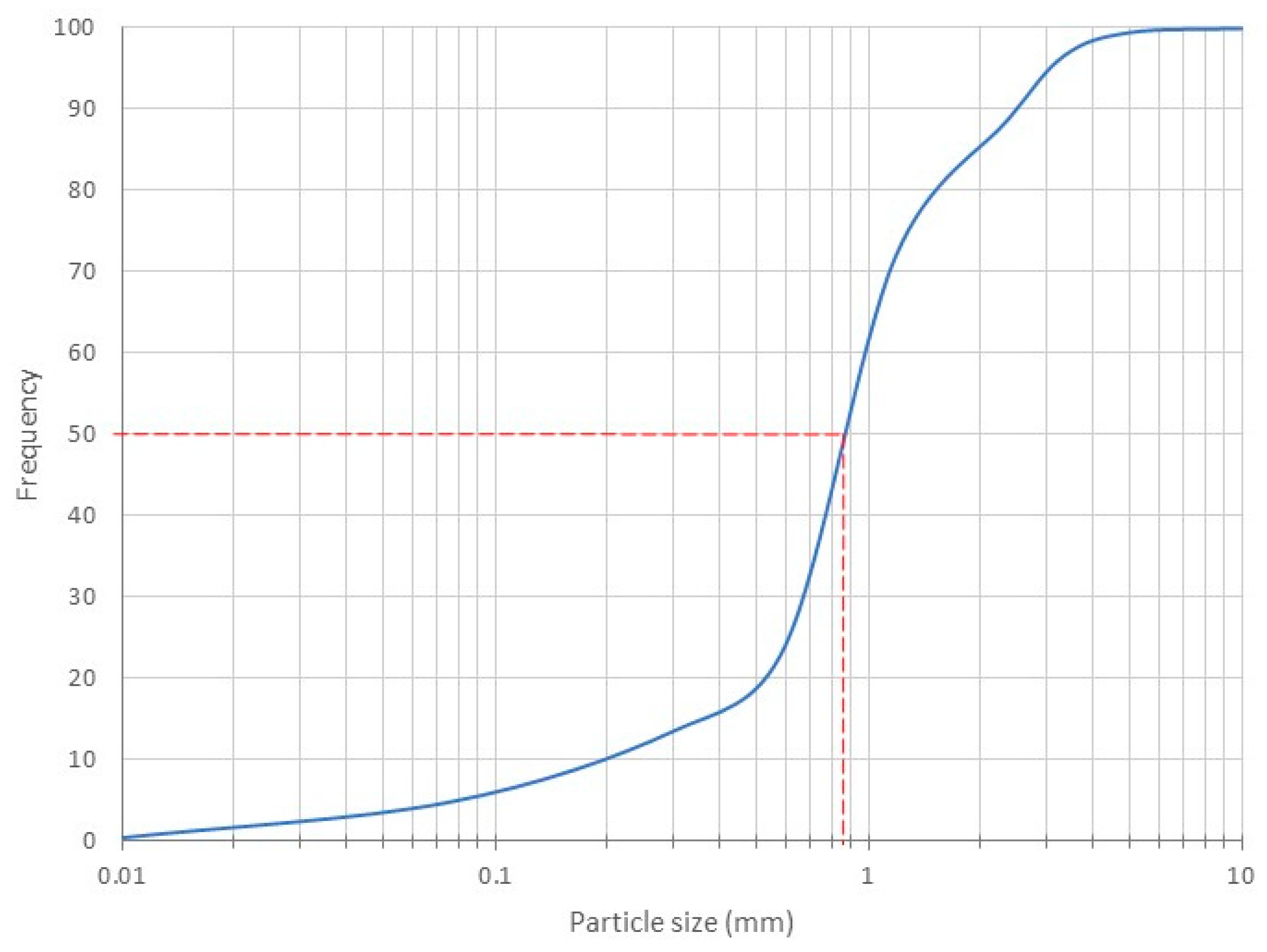
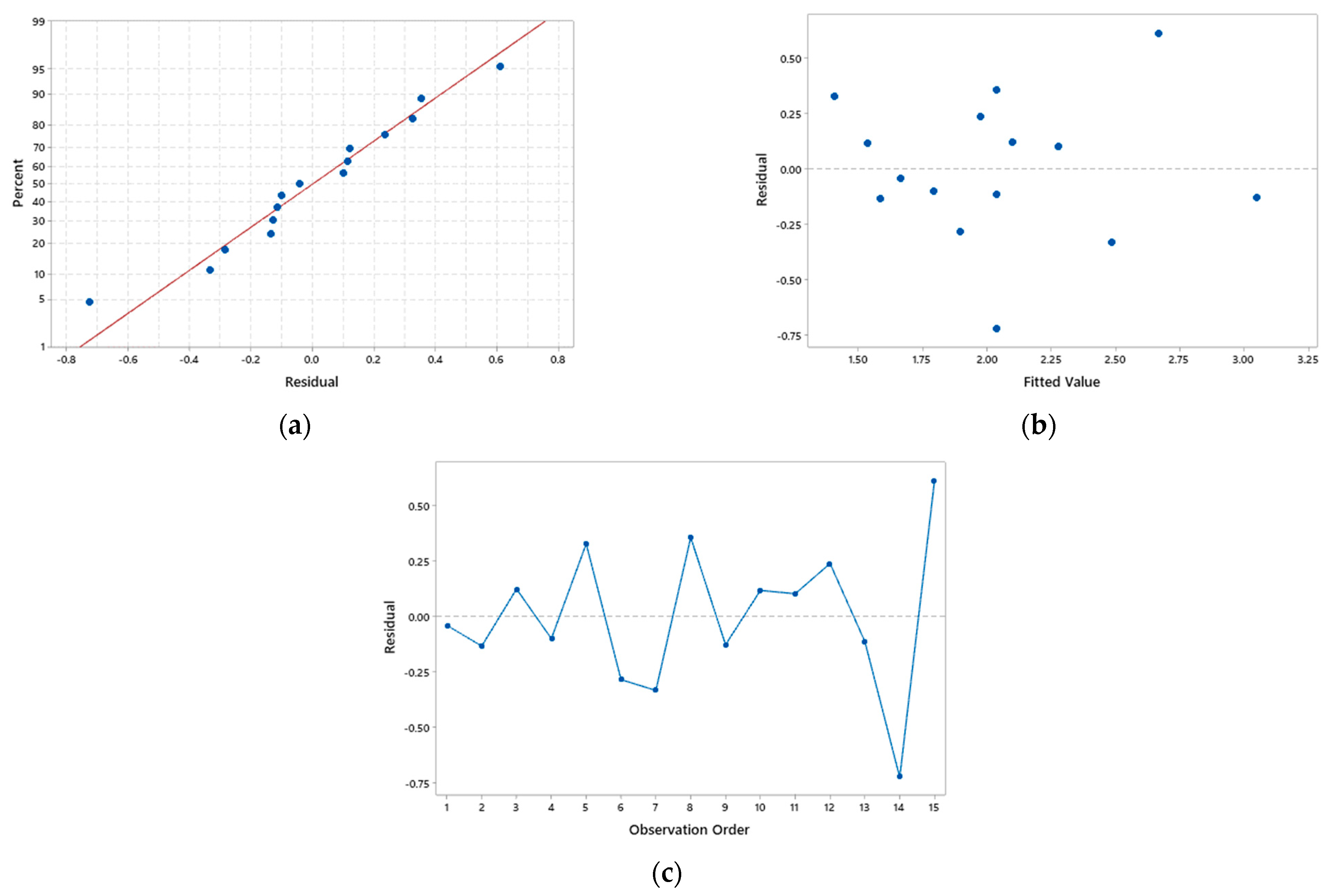
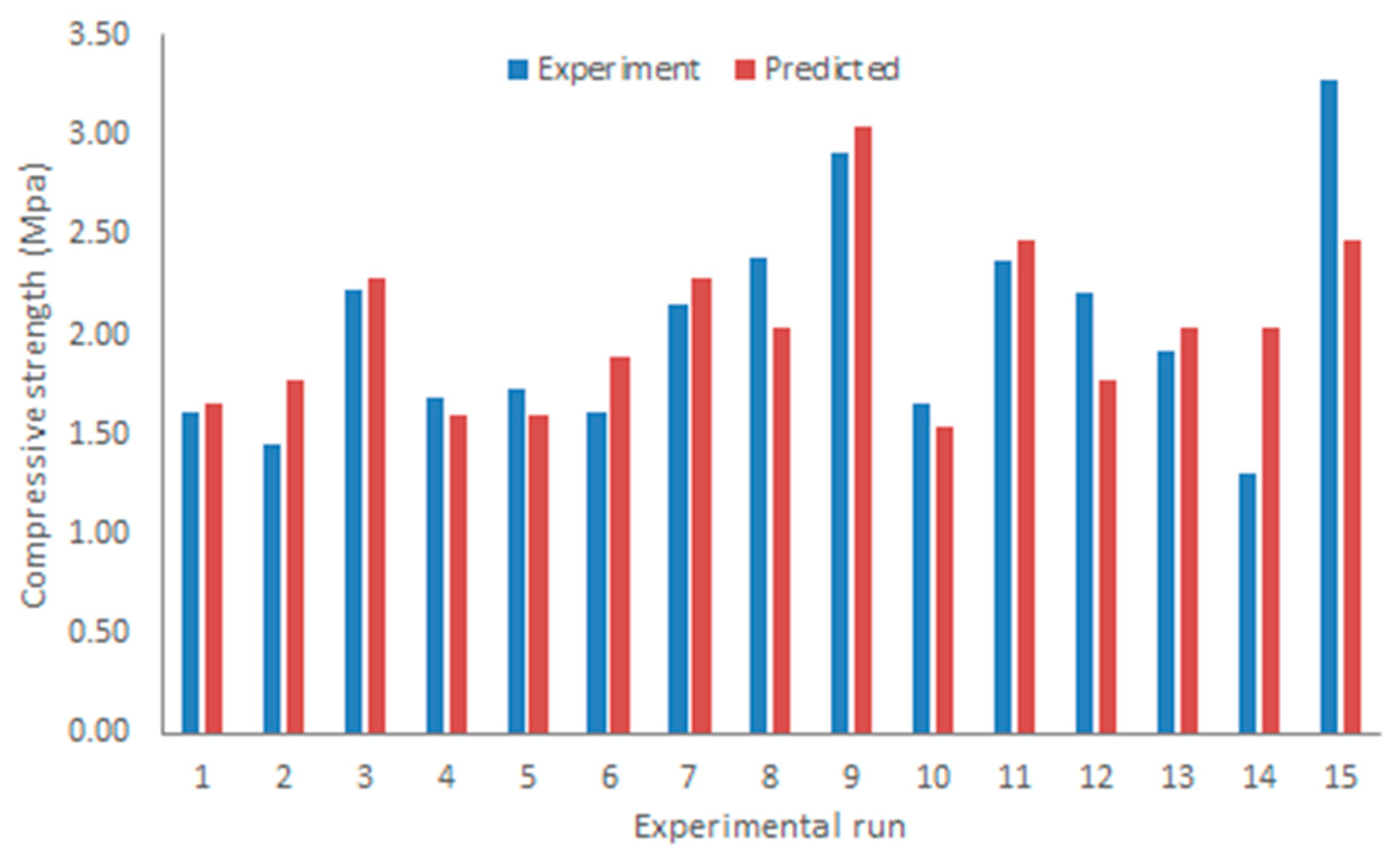

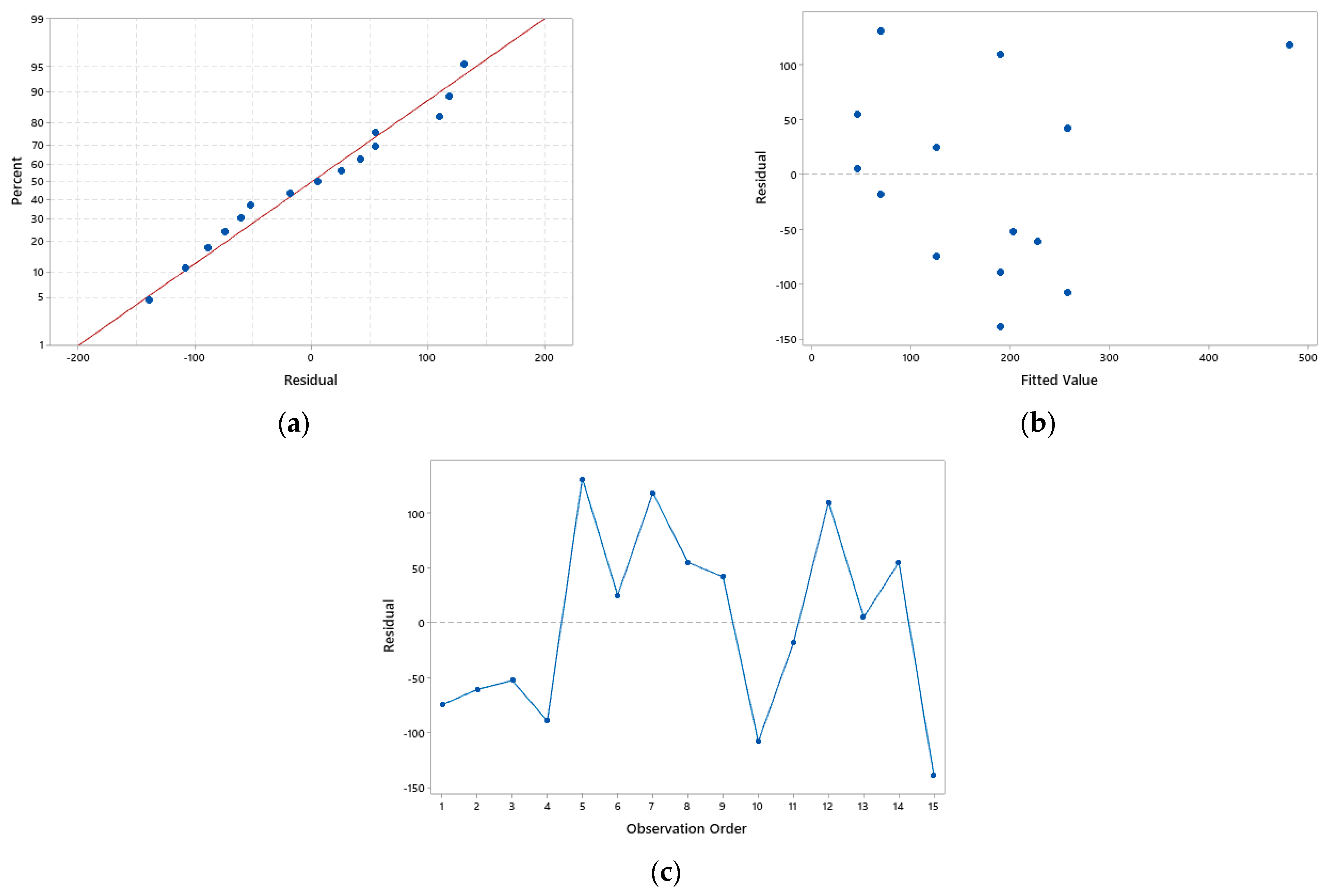
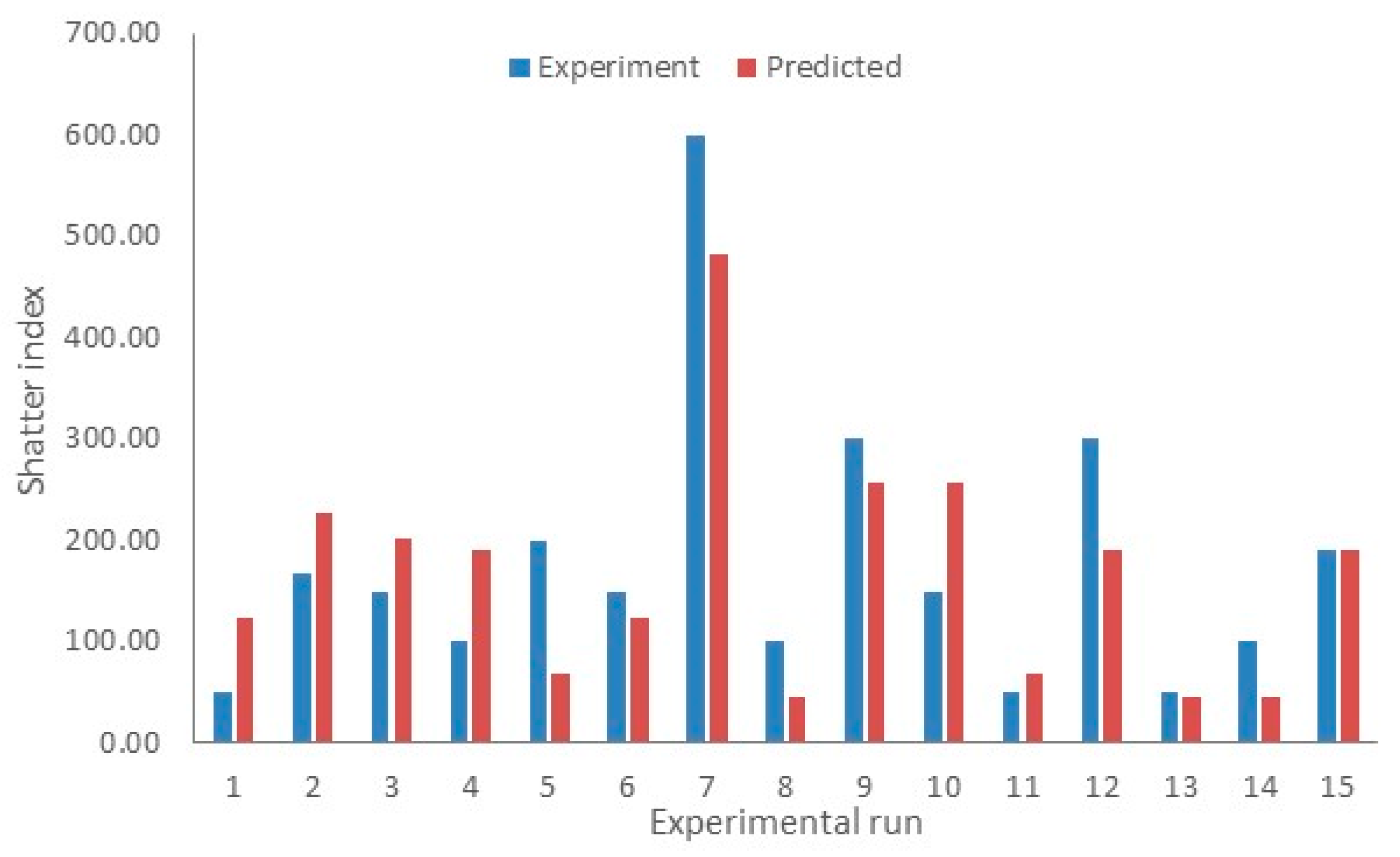

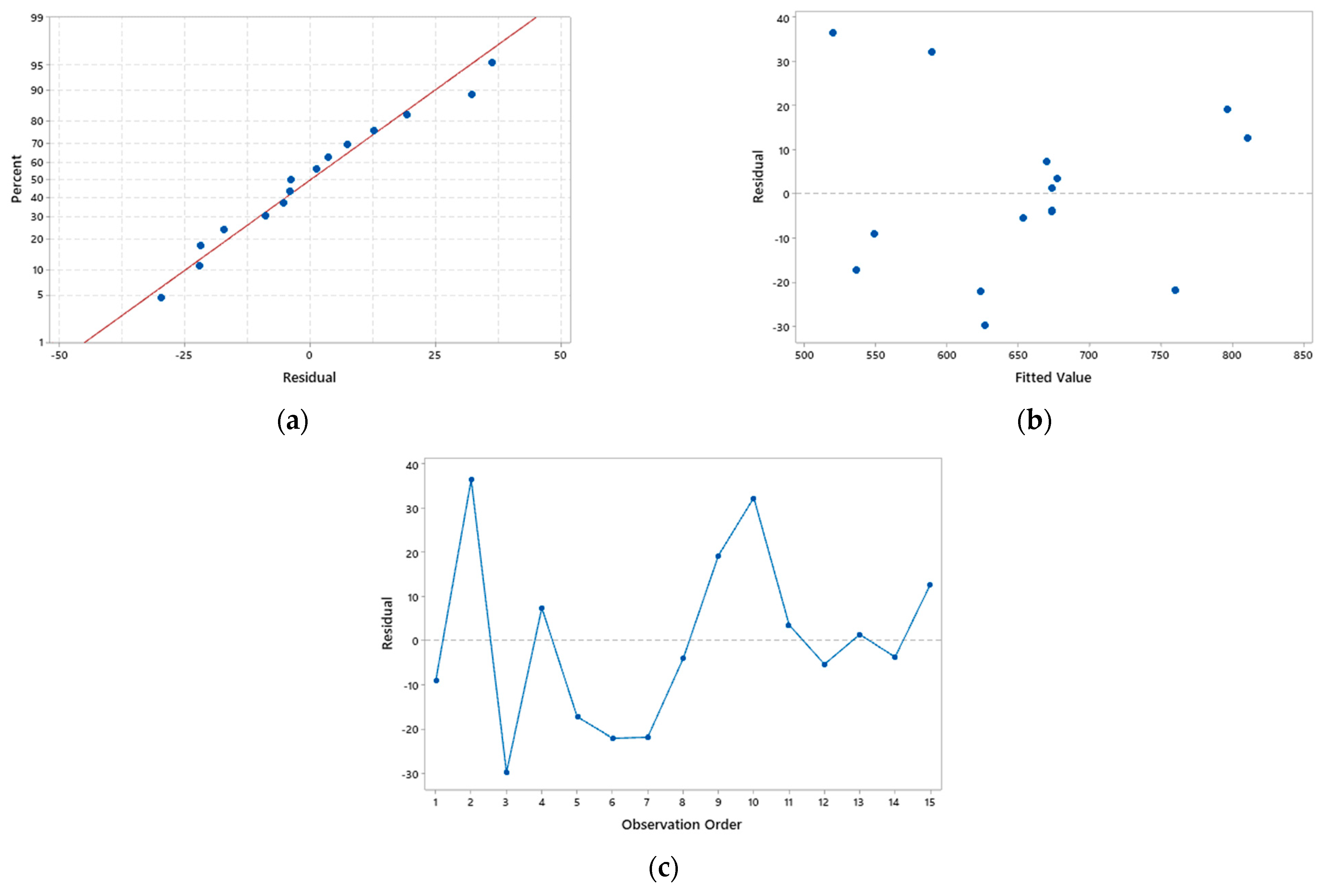
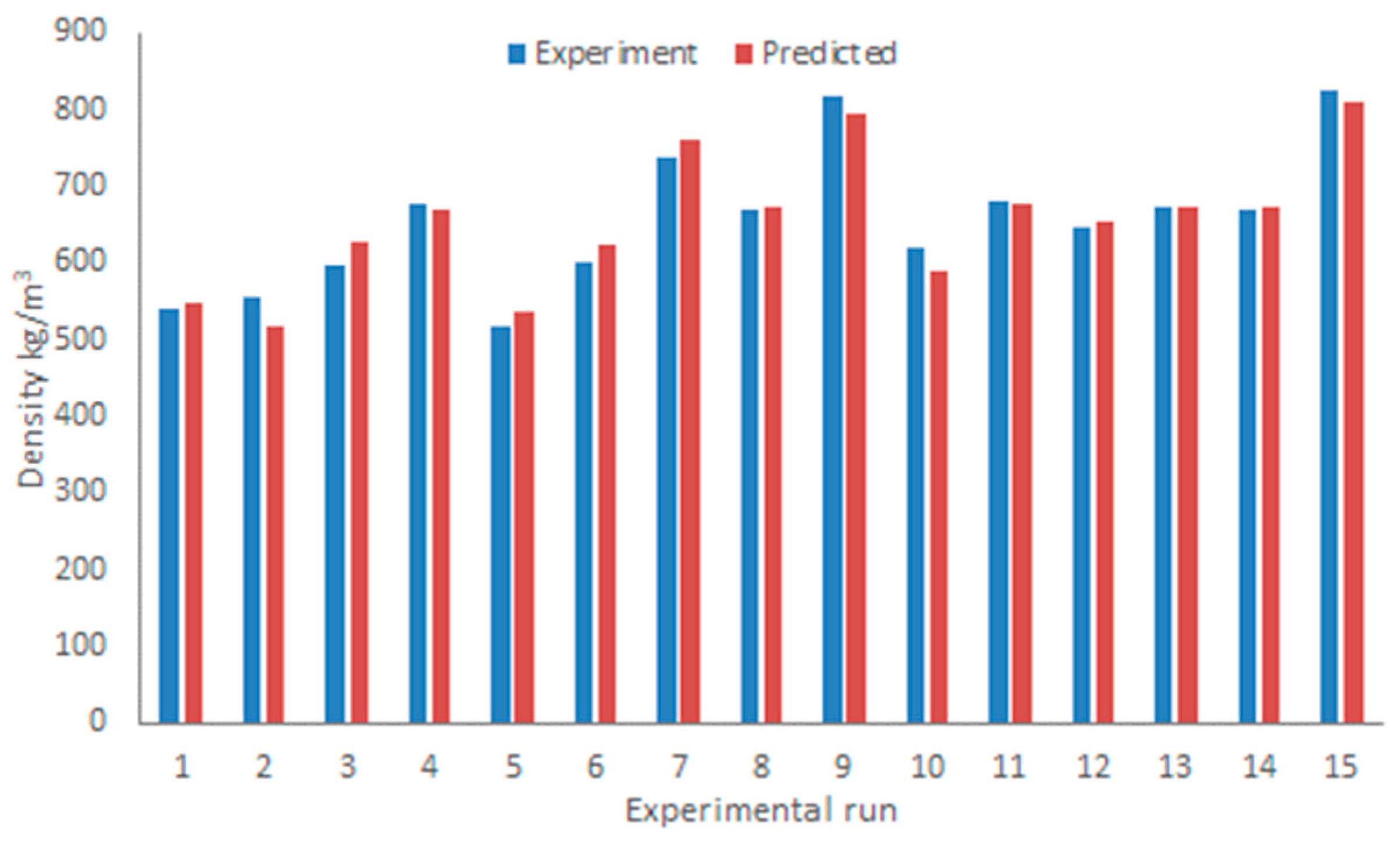
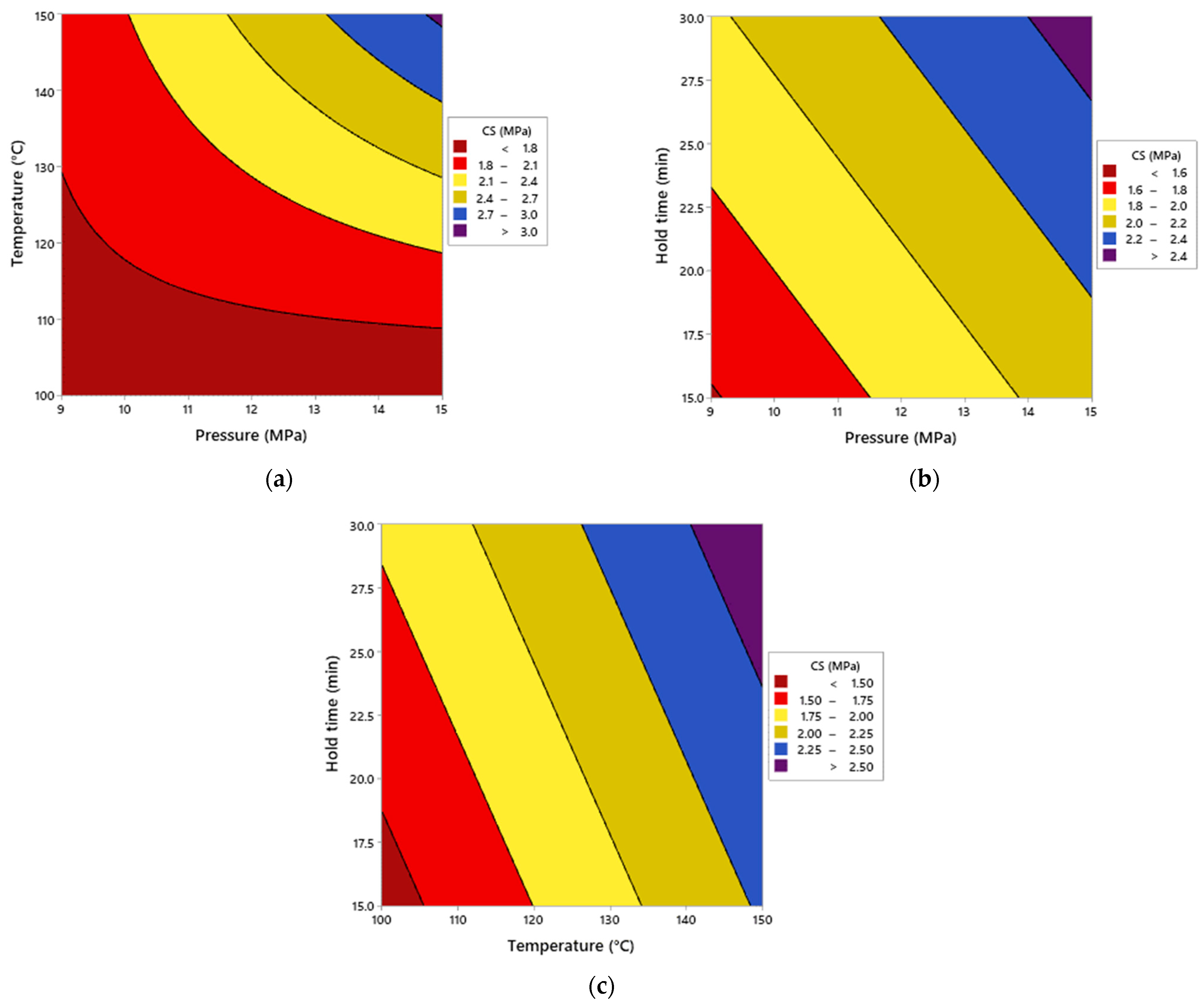
| Exp. No. | Variables | Responses | ||||
|---|---|---|---|---|---|---|
| Pressure (MPa) | Temperature (°C) | Hold Time (min) | CS (MPa) | SI | ||
| 1 | 9 | 100 | 22.5 | 2.54 | 50.0 | 539.5 |
| 2 | 9 | 125 | 15.0 | 2.27 | 166.7 | 555.6 |
| 3 | 15 | 125 | 15.0 | 3.48 | 150.0 | 596.4 |
| 4 | 12 | 100 | 30.0 | 2.66 | 100.0 | 677.3 |
| 5 | 12 | 100 | 15.0 | 2.71 | 200.0 | 518.8 |
| 6 | 9 | 150 | 22.5 | 2.53 | 150.0 | 601.7 |
| 7 | 15 | 125 | 30.0 | 3.38 | 600.0 | 738.1 |
| 8 | 12 | 125 | 22.5 | 3.76 | 100.0 | 669.5 |
| 9 | 15 | 150 | 22.5 | 4.58 | 300.0 | 815.9 |
| 10 | 15 | 100 | 22.5 | 2.59 | 150.0 | 621.6 |
| 11 | 12 | 150 | 15.0 | 3.74 | 50.0 | 680.9 |
| 12 | 9 | 125 | 30.0 | 3.47 | 300.0 | 647.7 |
| 13 | 12 | 125 | 22.5 | 3.01 | 50.0 | 675.0 |
| 14 | 12 | 125 | 22.5 | 2.06 | 100.0 | 669.9 |
| 15 | 12 | 150 | 30.0 | 5.15 | 50.0 | 823.9 |
| Source | DF | Adj SS | Adj MS | F-Value | p-Value |
|---|---|---|---|---|---|
| Model | 4 | 2.7665 | 0.6916 | 4.66 | 0.022 |
| Linear | 3 | 2.3569 | 0.7856 | 5.29 | 0.019 |
| Pressure (MPa) | 1 | 0.5253 | 0.5253 | 3.54 | 0.089 |
| Temperature (°C) | 1 | 1.5312 | 1.5312 | 10.32 | 0.009 |
| Hold time (min) | 1 | 0.3003 | 0.3003 | 2.02 | 0.185 |
| Two-Way Interaction | 1 | 0.4096 | 0.4096 | 2.76 | 0.128 |
| Pressure (MPa) ×Temperature (°C) | 1 | 0.4096 | 0.4096 | 2.76 | 0.128 |
| Error | 10 | 1.4841 | 0.1484 | ||
| Lack-of-Fit | 8 | 0.8976 | 0.1122 | 0.38 | 0.866 |
| Pure Error | 2 | 0.5865 | 0.2932 | ||
| Total | 14 | 4.2506 |
| Source | DF | Adj SS | Adj MS | F-Value | p-Value |
|---|---|---|---|---|---|
| Model | 5 | 189,694 | 37,938.9 | 3.30 | 0.057 |
| Linear | 2 | 106,836 | 53,418.1 | 4.65 | 0.041 |
| Pressure | 1 | 80,697 | 80,697.3 | 7.03 | 0.026 |
| Hold time | 1 | 26,139 | 26,138.8 | 2.28 | 0.166 |
| Square | 2 | 99,871 | 49,935.6 | 4.35 | 0.048 |
| Pressure×Pressure | 1 | 79,694 | 79,693.9 | 6.94 | 0.027 |
| Hold time×Hold time | 1 | 26,195 | 26,194.8 | 2.28 | 0.165 |
| Two-Way Interaction | 1 | 25,075 | 25,074.7 | 2.18 | 0.174 |
| Pressure×Hold time | 1 | 25,075 | 25,074.7 | 2.18 | 0.174 |
| Error | 9 | 103,343 | 11,482.5 | ||
| Lack-of-Fit | 7 | 101,676 | 14,525.1 | 17.43 | 0.055 |
| Pure Error | 2 | 1667 | 833.3 | ||
| Total | 14 | 293,037 |
| Source | DF | Adj SS | Adj MS | F-Value | p-Value |
|---|---|---|---|---|---|
| Model | 5 | 107,250 | 21,450.1 | 36.80 | 0.000 |
| Linear | 3 | 98,563 | 32,854.4 | 56.37 | 0.000 |
| Pressure (MPa) | 1 | 22,844 | 22,843.8 | 39.19 | 0.000 |
| Temperature (°C) | 1 | 39,915 | 39,914.8 | 68.48 | 0.000 |
| Hold time (min) | 1 | 35,805 | 35,804.8 | 61.43 | 0.000 |
| Square | 1 | 4327 | 4326.9 | 7.42 | 0.023 |
| Pressure (MPa) ×Pressure (MPa) | 1 | 4327 | 4326.9 | 7.42 | 0.023 |
| Two-Way Interaction | 1 | 4360 | 4360.1 | 7.48 | 0.023 |
| Pressure (MPa) ×Temperature (°C) | 1 | 4360 | 4360.1 | 7.48 | 0.023 |
| Error | 9 | 5246 | 582.8 | ||
| Lack-of-Fit | 7 | 5227 | 746.7 | 79.82 | 0.012 |
| Pure Error | 2 | 19 | 9.4 | ||
| Total | 14 | 112,496 |
| Parameter | CS | SI | D |
|---|---|---|---|
| CS | 1.000 | ||
| SI | 0.104 | 1.000 | |
| D | 0.763 | 0.217 | 1.000 |
Disclaimer/Publisher’s Note: The statements, opinions and data contained in all publications are solely those of the individual author(s) and contributor(s) and not of MDPI and/or the editor(s). MDPI and/or the editor(s) disclaim responsibility for any injury to people or property resulting from any ideas, methods, instructions or products referred to in the content. |
© 2024 by the authors. Licensee MDPI, Basel, Switzerland. This article is an open access article distributed under the terms and conditions of the Creative Commons Attribution (CC BY) license (https://creativecommons.org/licenses/by/4.0/).
Share and Cite
Orisaleye, J.I.; Jekayinfa, S.O.; Ogundare, A.A.; Shittu, M.R.; Akinola, O.O.; Odesanya, K.O. Effects of Process Variables on Physico-Mechanical Properties of Abura (Mitrogyna ciliata) Sawdust Briquettes. Biomass 2024, 4, 671-686. https://doi.org/10.3390/biomass4030037
Orisaleye JI, Jekayinfa SO, Ogundare AA, Shittu MR, Akinola OO, Odesanya KO. Effects of Process Variables on Physico-Mechanical Properties of Abura (Mitrogyna ciliata) Sawdust Briquettes. Biomass. 2024; 4(3):671-686. https://doi.org/10.3390/biomass4030037
Chicago/Turabian StyleOrisaleye, Joseph Ifeolu, Simeon Olatayo Jekayinfa, Adebayo Adeyemi Ogundare, Mojirade Rashidat Shittu, Oluwatomiwa Olalekan Akinola, and Kazeem Olabisi Odesanya. 2024. "Effects of Process Variables on Physico-Mechanical Properties of Abura (Mitrogyna ciliata) Sawdust Briquettes" Biomass 4, no. 3: 671-686. https://doi.org/10.3390/biomass4030037
APA StyleOrisaleye, J. I., Jekayinfa, S. O., Ogundare, A. A., Shittu, M. R., Akinola, O. O., & Odesanya, K. O. (2024). Effects of Process Variables on Physico-Mechanical Properties of Abura (Mitrogyna ciliata) Sawdust Briquettes. Biomass, 4(3), 671-686. https://doi.org/10.3390/biomass4030037










